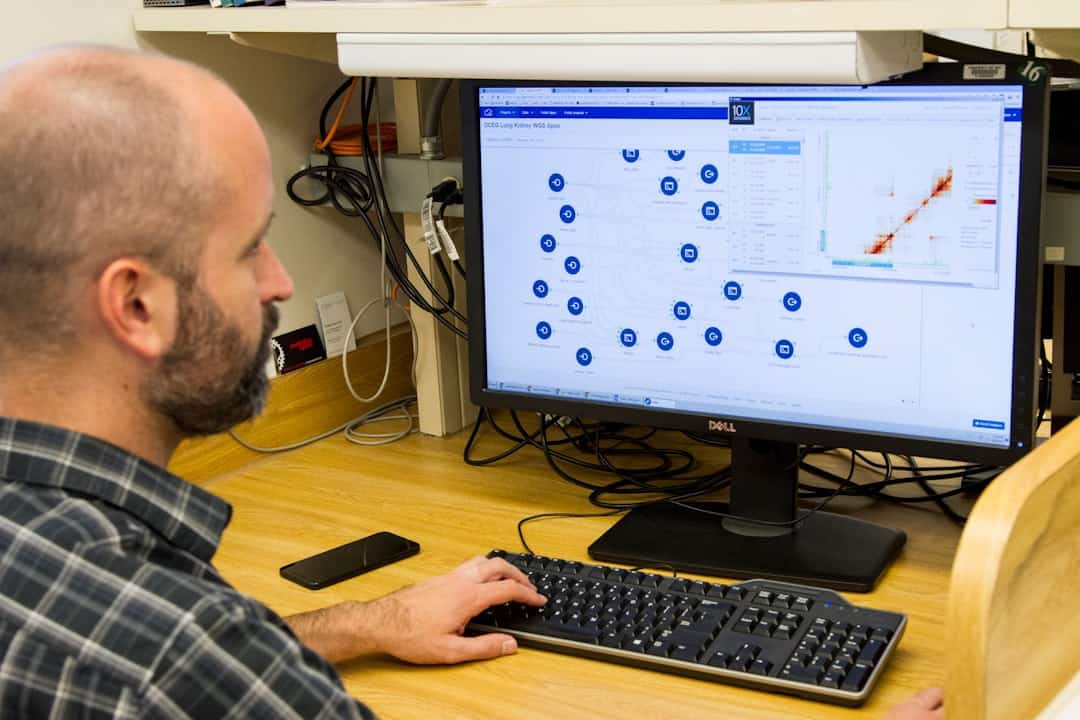Machine learning and deep learning are subfields of artificial intelligence that have gained prominence in recent years. Machine learning involves training algorithms to identify patterns and make decisions based on data without explicit programming. Deep Learning, a more sophisticated form of machine learning, utilizes neural networks to mimic human brain processing and learning from data.
Both approaches require substantial amounts of data to train algorithms and enhance their accuracy over time. Machine learning algorithms are typically trained using labeled data, where input data is associated with the correct output. The algorithm learns from these examples to make predictions on new, unseen data.
Deep learning expands on this concept by employing multiple layers of interconnected nodes or neurons to process and learn from data. This architecture enables deep learning algorithms to automatically discover complex patterns and features within input data, making them particularly effective for tasks such as image and speech recognition.
Key Takeaways
- Machine learning involves training a computer to learn from data, while deep learning uses neural networks to imitate the human brain’s ability to process data.
- Machine learning and deep learning have applications in various fields such as healthcare, finance, marketing, and autonomous vehicles.
- These technologies can be used to analyze large datasets, identify patterns, and make predictions based on the data.
- Natural language processing (NLP) uses machine learning and deep learning to understand and generate human language, enabling chatbots, language translation, and sentiment analysis.
- By using machine learning and deep learning, organizations can make better decisions and improve predictive analytics for business outcomes.
Exploring the Applications of Machine Learning and Deep Learning in AI
Healthcare and Finance
In the field of healthcare, these technologies are being used to analyze medical images, diagnose diseases, and predict patient outcomes. In finance, machine learning algorithms are used for fraud detection, risk assessment, and algorithmic trading.
Autonomous Vehicles and User Experience
In the field of autonomous vehicles, deep learning is used for object detection, path planning, and decision making. In addition to these practical applications, machine learning and deep learning are also being used to enhance user experiences in various industries. For example, recommendation systems that use machine learning algorithms are used by streaming services, e-commerce platforms, and social media websites to personalize content for users.
Natural Language Processing
Natural language processing, a branch of AI that focuses on enabling computers to understand, interpret, and generate human language, also heavily relies on machine learning and deep learning techniques.
Leveraging Machine Learning and Deep Learning for Data Analysis and Pattern Recognition

One of the key strengths of machine learning and deep learning is their ability to analyze large volumes of data and identify complex patterns that may not be apparent to human analysts. This makes them invaluable tools for data analysis and pattern recognition in a wide range of industries. In finance, for example, machine learning algorithms can be used to detect fraudulent transactions by identifying patterns that deviate from normal behavior.
In manufacturing, these technologies can be used to optimize production processes by analyzing sensor data and identifying potential issues before they occur. In addition to traditional data analysis tasks, machine learning and deep learning are also being used for more advanced pattern recognition tasks such as image and speech recognition. These technologies have made significant advancements in recent years, with deep learning algorithms achieving human-level performance in tasks such as object detection and speech transcription.
This has opened up new possibilities for applications such as autonomous vehicles, medical imaging, and natural language processing.
Harnessing the Potential of Machine Learning and Deep Learning in Natural Language Processing
| Metrics | Description |
|---|---|
| Accuracy | The percentage of correctly predicted results |
| Precision | The ratio of correctly predicted positive observations to the total predicted positive observations |
| Recall | The ratio of correctly predicted positive observations to the all observations in actual class |
| F1 Score | The weighted average of Precision and Recall |
| Perplexity | A measurement of how well a probability model predicts a sample |
Natural language processing (NLP) is a field of artificial intelligence that focuses on enabling computers to understand, interpret, and generate human language in a valuable way. Machine learning and deep learning have played a crucial role in advancing the capabilities of NLP systems. For example, machine learning algorithms are used for tasks such as text classification, sentiment analysis, and named entity recognition.
Deep learning techniques such as recurrent neural networks (RNNs) and transformers have also been instrumental in improving the accuracy of language translation systems. In addition to these applications, machine learning and deep learning are also being used to develop conversational AI systems such as chatbots and virtual assistants. These systems rely on natural language understanding and generation capabilities to interact with users in a human-like manner.
As these technologies continue to advance, we can expect to see more sophisticated NLP systems that can understand context, generate coherent responses, and even exhibit a degree of emotional intelligence.
Enhancing Decision Making and Predictive Analytics with Machine Learning and Deep Learning
One of the key benefits of machine learning and deep learning is their ability to make sense of complex data and make predictions based on that data. This has significant implications for decision making and predictive analytics in various industries. For example, in marketing, machine learning algorithms can be used to analyze customer data and predict which products a customer is likely to purchase next.
In healthcare, predictive analytics can be used to identify patients who are at risk of developing certain conditions based on their medical history and lifestyle factors. In addition to making predictions, machine learning and deep learning can also be used to optimize decision-making processes by automating routine tasks and providing insights that may not be apparent to human analysts. This can lead to more efficient operations, cost savings, and improved outcomes in areas such as supply chain management, resource allocation, and risk assessment.
Overcoming Challenges and Limitations in Implementing Machine Learning and Deep Learning

While machine learning and deep learning have shown great promise in various applications, there are still challenges and limitations that need to be addressed. One of the main challenges is the need for large amounts of labeled training data to train accurate models. In some domains, obtaining labeled data can be time-consuming and expensive, which can limit the applicability of machine learning and deep learning techniques.
Another challenge is the interpretability of machine learning models. Deep learning models in particular are often referred to as “black boxes” because it can be difficult to understand how they arrive at their predictions. This lack of transparency can be a barrier to adoption in domains where interpretability is crucial, such as healthcare and finance.
The Future of AI: Advancements in Machine Learning and Deep Learning
Despite these challenges, the future of artificial intelligence looks promising with ongoing advancements in machine learning and deep learning. Researchers are actively working on developing techniques to address the limitations of these technologies, such as transfer learning, which allows models to be trained on one task and then applied to another related task with minimal additional training. In addition to technical advancements, there is also growing interest in ethical considerations surrounding the use of AI technologies.
As machine learning and deep learning systems become more pervasive in our daily lives, it is important to ensure that they are developed and deployed in a responsible manner that respects privacy, fairness, and transparency. Overall, machine learning and deep learning have already had a profound impact on various industries, and their potential for future advancements is immense. As these technologies continue to evolve, we can expect to see even more innovative applications that will transform the way we live and work.
If you’re interested in the intersection of machine learning and virtual reality, you may want to check out this article on augmented reality (AR). The article discusses how AR technology is being used in various industries and how machine learning and deep learning are playing a crucial role in enhancing the user experience in AR applications.
FAQs
What is machine learning?
Machine learning is a subset of artificial intelligence that involves the development of algorithms and statistical models that enable computers to improve their performance on a specific task through experience, without being explicitly programmed.
What is deep learning?
Deep learning is a subset of machine learning that uses artificial neural networks with multiple layers (hence the term “deep”) to learn from large amounts of data. It is particularly effective for tasks such as image and speech recognition.
What are the applications of machine learning and deep learning?
Machine learning and deep learning have a wide range of applications, including but not limited to:
– Image and speech recognition
– Natural language processing
– Recommendation systems
– Autonomous vehicles
– Healthcare diagnostics
– Financial forecasting
– Fraud detection
What are some popular machine learning and deep learning algorithms?
Some popular machine learning algorithms include:
– Linear regression
– Decision trees
– Random forests
– Support vector machines
– K-nearest neighbors
Some popular deep learning algorithms include:
– Convolutional neural networks (CNNs)
– Recurrent neural networks (RNNs)
– Long short-term memory (LSTM) networks
– Generative adversarial networks (GANs)
What are the differences between machine learning and deep learning?
The main difference between machine learning and deep learning is the level of abstraction in the feature extraction process. In machine learning, features are typically handcrafted by domain experts, while in deep learning, features are automatically learned from the data.
What are some common challenges in machine learning and deep learning?
Some common challenges in machine learning and deep learning include:
– Overfitting
– Data quality and quantity
– Interpretability of models
– Computational resources and training time
– Ethical and privacy concerns











Leave a Reply